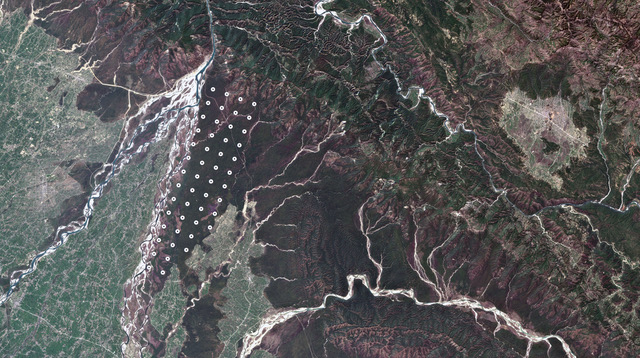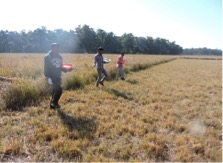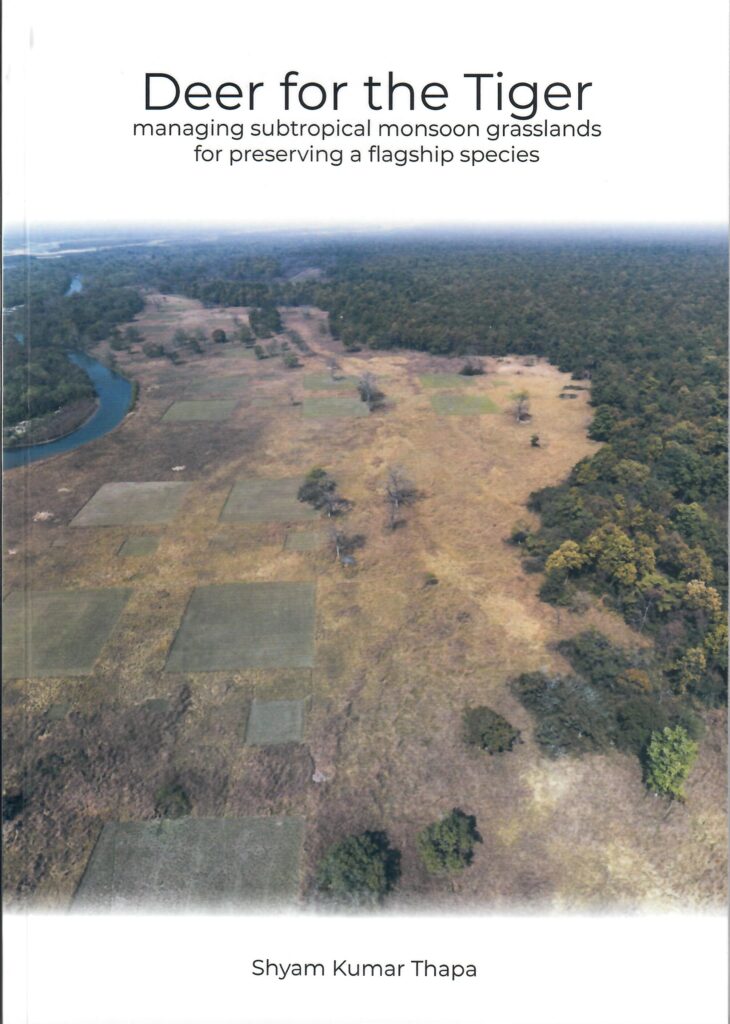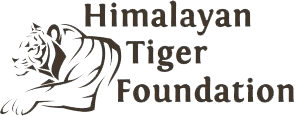Welcome to the renewed website of the Himalayan Tiger Foundation. The upcoming year signifies for us ‘full speed ahead’ once again, in collaboration with our Nepalese and Dutch partners.
But also, as the Romans said: “Tempora mutantur, et nos mutamur in illis.” In other words: “Times change, and we change with them.” We are expanding our focus from ‘Safeguarding the tiger from extinction’ (which has been successful) to topics such as ‘How can people in densely populated areas coexist with wild animals nearby’ and ‘What are the consequences of climate change’?
Success|
The significant success of the ‘Double The Tiger Number‘ project, which has more than doubled the tiger population in the national parks south of the Nepalese Himalayas in the past decade – and even tripled it in Bardiya – has the unintended consequence that tigers sometimes prey on a cow or a goat, and even on an occasional resident from nearby villages. The number of human victims of this so-called ‘Human Tiger Conflict’ has been growing in recent years. It goes without saying that the local support from the population for the conservation of tigers is under pressure.
The question arises: do these tigers have enough to eat? It is an illusion to assume that tigers are eager to become vegetarian. They want meat! If the goal is to maintain a healthy tiger population, there must be enough prey animals – primarily deer – available.
Therefore, the research conducted by Shyam Thapa, on which he earned his PhD from Wageningen University on December 6, 2023, is of great importance. Shyam has examined in recent years what measures would be necessary in the Bardiya National Park in Southwest Nepal to produce more grass (and for deer it means: better grass), thereby increasing the number of these animals. This, in turn, can serve as a meal for the growing tiger population.

dr. Shyam Thapa with promotor prof.dr. em Herbert Prins and supervisors dr. Joost de Jong, dr. Anouschka Hof and dr. Naresh Subedi
The Beginning
On a beautiful morning in the fall of 2018, I have the pleasure of being a part of Shyam’s fieldwork. He sets up several test fields where he will conduct experiments: how do I influence the growth of better grass varieties that deer prefer to eat? The terrain is currently mostly covered with tall grass – colloquially known as ‘Elephant grass’ (Saccharum species) – which is entirely unsuitable as food for deer. Deer prefer nutrient-rich, short grass, for example Cynodon dactylon or the short leaves of Imperata cylindrica.
Shyam stands tall as a general on the back of an elephant, occasionally half-hidden among the tall blades of the Elephant grass. The terrain is located in an area of Bardiya that was once a village – until recently, cows grazed there. In his hand, he holds a long measuring tape. Around him, several staff members from the National Trust for Nature Conservation (NTNC) are busy marking the experimental plots with sticks and ropes, ultimately in three different sizes: 60 × 60 m, 20 x 20 m, and 7 x 7 meters. Several of these plots with different management regimes are set up: whether or not to mow, whether or not to fertilize with nitrogen or phosphorus. The ultimate goal is to determine on which plots the best grass for deer will grow.
There are two such areas in the Bardiya National Park, following a plan designed by Shyam’s supervisor, prof.dr. em Herbert Prins from Wageningen, which he has used in South Africa.
Unnatural?
Certainly, all of this is very labor-intensive. Mowing is done by hand, fertilizing as well. The short grass begins to grow: on which of the plots does it thrive the best? And how do the deer react to it? Over several seasons the number of these animals is counted based on the number of droppings found.
Mowing? Fertilizing? Isn’t that a bit ‘unnatural’? Why do we intervene in a way that strongly resembles farming practices? Ultimately, it is a political choice as articulated in proposition 6 of Shyam’s dissertation: “Conservation of flagship species is a political agenda.” The desire to double the global tiger population was documented in a declaration during the St. Petersburg Conference in November 2013, co-signed by the government of Nepal. But, how do you achieve that?
Allowing ‘nature to take its course’, without any intervention, is likely not a viable option to increase the tiger population. Over time, the grasslands in the national parks of South Nepal would be overrun by tall Elephant grass – and subsequently, trees would take over. The number of deer, such as the Chital, would decline. Ultimately, the tiger would suffer unless they could start preying on livestock (and villagers).
In other words, the choice to allow tigers to thrive involves an approach of ‘interventions,’ and Wageningen excels in this. The approach has been extensively communicated with the Nepalese Department of National Parks and Wildlife Conservation (DNPWC), Ministry of Forest of Nepal, and the National Trust for Nature Conservation (NTNC). These agencies provided immediate approval. With positive outcomes – because the conclusions in Shyam’s dissertation are crystal clear: ‘grass suitable for deer’ flourishes well under a regime of more frequent mowing and light fertilization.



Long term
However, these kinds of interventions… is this intended for the long term? Mowing is labor-intensive and therefore expensive. Moreover, it seems not a good idea that mowing machines will be driving around in the park again every season. The ultimate goal is that, over time, the so-called ‘large grazers,’ such as Gaur (Indian bison – Bos gaurus), will take over this regime. This enormous animal also consumes the tall grass that deer avoid. A Nilgai (Blue bull – Boselaphus tragocamelus) could also play a role.
The Gaur is not (anymore?) present in Bardiya. Nilgai are rare. In other parts of Nepal, they are found in larger numbers. The plan is to reintroduce them to the area in the coming years, making mowing probably unnecessary. Furthermore, a tiger catching a Gaur or Nilgai is in luck; these animals are much larger than a Chital and ensure a nutritious meal for an extended period while requiring only one hunting session. So, it’s a win-win.
In the ideal scenario, the grazing pressure from the ‘large and medium-sized grazers’ on the vegetation is so high that continuous regrowth of nutrient-rich grass species is encouraged. This creates a positive feedback-loop between grazing and vegetation, allowing these grasslands to be sustained by herbivores alone, without further management measures. Whether this will become a reality is still uncertain, but one thing is certain: doing nothing puts the tiger at risk.
Additionally, the size of the grazing fields is crucial. On a small field surrounded by bushes and tall grass, deer feel less secure than on larger grasslands. A tiger at the edge of a large field needs more time to reach its prey. Deer instinctively know this. Hence the reason that more droppings were found in the middle of the larger grasslands than at the edges – in other words, most deer stay in the middle while grazing.

Recommendations
Shyam’s doctoral defense has been well-received in Nepal, and it is heartening to see that his recommendations have already been implemented in other natural areas, such as Chitwan National Park. More such grazing lawns are emerging as a result.
Moreover, it is unique in Asia. Partly through Shyam’s effort, nature conservation in Nepal related to this type of management has reached a higher level. Additionally, it is evident that Shyam Thapa himself, who has stayed several years in the field and between 2018 and 2023 has spent extended periods in Wageningen, has clearly matured into a level of a seasoned scientist with profound knowledge and insight. He can contribute to providing a strong foundation for the nature conservation efforts in Nepal – and in Asia.

